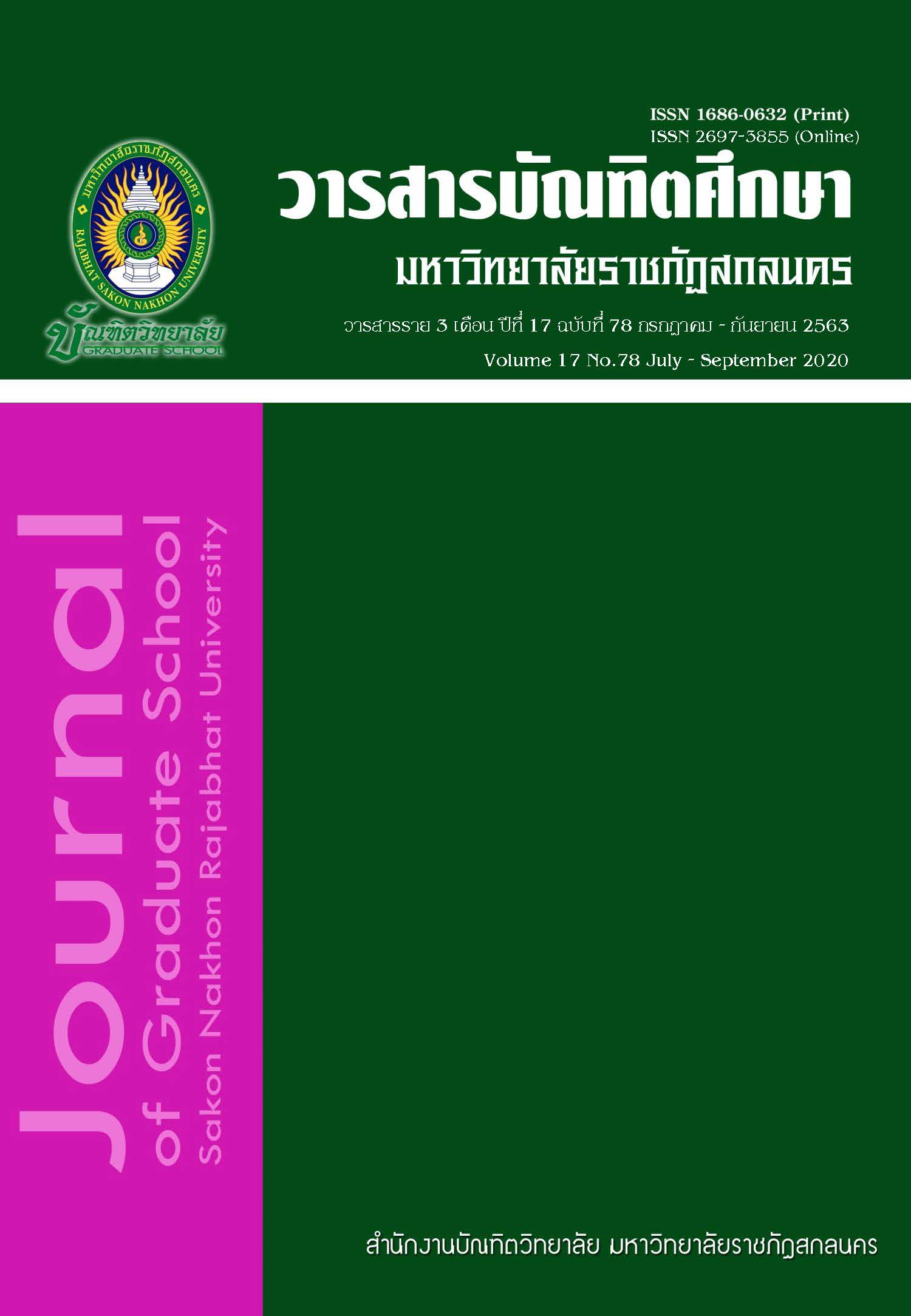การพัฒนาทักษะการเรียนรู้และนวัตกรรม รายวิชาฟิสิกส์ เรื่อง ของไหล ของนักเรียนชั้นมัธยมศึกษาปีที่ 6 โดยใช้การจัดการเรียนรู้แบบสะเต็มศึกษา
Main Article Content
Abstract
The purposes of this research were to develop Mathayomsuksa 6 students’ learning and innovation skills and learning achievement in the Physics subject of Hydrodynamics in STEM Education, with the average scores of at least 80 percent of total score, and the total number of the students passing the criteria of 80 percent. The target group included 40 Mathayomsuksa 6 students of Songdaowittayakhom school under the Secondary Education Service Area Office 23 during the second semester of academic year 2018. The instruments for this research were: 1) six lesson plans of the Physics subject on the topic of Hydrodynamics in STEM Education, 2) a teaching behavior observation form 3) a students’ learning behavior observation form, 4) Instruction records, 5) a learning and innovation skills’ assessment form, 6) an end-of-spiral learning and innovation skills test, 7) a learning achievement test concerning the Physics subject on the topic of Hydrodynamics. Quantitative data was analyzed by descriptive statistics consisting of mean (), standard deviation (S.D.), and percentage (%). Qualitative data was analyzed by using content analysis.
The findings were as follows: 1) the students had average scores of learning and innovation skills for 80.30 of the total score 92 or 87.29 percent, with 35 students or 85.00 percent passing the criteria which were higher than the defined criteria; and 2) The students had average scores of learning achievement for 60.23 or 86.04 percent of the total score with 35 students or 87.50 percent passing the criteria which were higher than defined criteria.
Article Details
บทความทุกบทความที่ตีพิมพ์ในวารสารบัณฑิตศึกษา มหาวิทยาลัยราชภัฏสกลนคร ถือว่าเป็นลิขสิทธิ์ของบัณฑิตวิทยาลัย มหาวิทยาลัยราชภัฏสกลนคร
References
กนกทิพย์ ยาทองไชย. (2559). การพัฒนาชุดกิจกรรมสะเต็มศึกษา เรื่อง ปิโตรเลียมและพลังงานทดแทน เพื่อส่งเสริมการคิดอย่างมีวิจารณญาณและการแก้ปัญหา ระดับมัธยมศึกษาตอนปลาย. วิทยานิพนธ์ กศ.ม. กรุงเทพฯ: มหาวิทยาลัยศรีนครินทรวิโรฒ.
กระทรวงศึกษาธิการ. (2551). หลักสูตรแกนกลางการศึกษาขั้นพื้นฐาน พุทธศักราช 2551. กรุงเทพฯ: ชุมนุมสหกรณ์การเกษตรแห่งประเทศไทย.
ดวงพร สมจันทร์ตา. (2559). การพัฒนาความสามารถในการแก้ปัญหาทางวิทยาศาสตร์ของนักเรียนระดับชั้นมัธยมศึกษาตอนปลายที่ได้รับการเรียนตามแนวทางสะเต็มศึกษา เรื่อง กายวิภาคศาสตร์ของพืช. วิทยานิพนธ์ กศ.ม. กรุงเทพฯ: มหาวิทยาลัยศรีนครินทรวิโรฒ.
พรทิพย์ ศิริภัทราชัย. (2556). STEM Education กับการพัฒนาทักษะในศตวรรษที่ 21. วารสารนักบริหาร, 33(2), 49 - 56.
พลศักดิ์ แสงพรมศรี. (2558). การเปรียบเทียบผลสัมฤทธิ์ทางการเรียน ทักษะกระบวนการทางวิทยาศาสตร์ขั้นสูง และเจตคติต่อการเรียนเคมี ของนักเรียนชั้นมัธยมศึกษาปีที่ 5 ที่ได้รับการจัดการเรียนรู้สะเต็มศึกษากับแบบปกติ. วารสารศึกษาศาสตร์ มหาวิทยาลัยมหาสารคาม, 9(ฉบับพิเศษ), 401 - 418.
โรงเรียนส่องดาววิทยาคม. (2561). รายงานการประเมินตนเองของสถานศึกษา ประจำปีการศึกษา 2560 โรงเรียนส่องดาววิทยาคม. สกลนคร: ราชยานยนต์.
วิจารณ์ พานิช. (2555). วิถีสร้างการเรียนรู้เพื่อศิษย์ในศตวรรษที่ 21. กรุงเทพฯ: มูลนิธิสดศรีสฤษดิ์วงศ์.
ศูนย์สะเต็มศึกษาแห่งชาติ. (2558). คู่มือหลักสูตรอบรมครูสะเต็มศึกษา. เข้าถึงได้จาก http://www.stemedthailand.org/wp-content/uploads/2015/03/newIntro-to-STEM.pdf.pdf. 9 เมษายน 2561.
สถาบันส่งเสริมการสอนวิทยาศาสตร์และเทคโนโลยี. (2556). เอกสารการจัดกิจกรรมการเรียนรู้สะเต็มศึกษา. กรุงเทพฯ: สถาบันส่งเสริมการสอนวิทยาศาสตร์และเทคโนโลยี
สถาบันส่งเสริมการสอนวิทยาศาสตร์และเทคโนโลยี. (2546). การจัดสาระการเรียนรู้กลุ่มวิทยาศาสตร์หลักสูตรการศึกษาขั้นพื้นฐาน. กรุงเทพฯ: คุรุสภาลาดพร้าว.
สำนักงานบริหารงานการมัธยมศึกษาตอนปลาย. (2558). แนวทางการจัดทักษะการเรียนรู้ในศตวรรษที่ 21 ที่เน้นสมรรถนะทางสาขาวิชาชีพ. กรุงเทพฯ: ชุมนุมสหกรณ์การเกษตรแห่งประเทศไทย.
อโนดาษ์ รัชเวทย์. (2560). การพัฒนาทักษะการเรียนรู้และนวัตกรรมในศตวรรษที่ 21 โดยใช้ชุดการเรียนการสอนตามแนวสะเต็มศึกษาเรื่อง การแยกสาร ของนักเรียนชั้นมัธยมศึกษาปีที่ 2. วารสารวิชาการมหาวิทยาลัยฟาร์อีสเทอร์น, 11(3), 226 - 238.
อาทิตยา พูนเรือง. (2559). การเปรียบเทียบผลสัมฤทธิ์ทางการเรียนและความสามารถในการแก้ปัญหาทางวิทยาศาสตร์ เรื่อง เคมีที่เป็นพื้นฐานของสิ่งมีชีวิต โดยการจัดการเรียนรู้ตามแนวทางสะเต็มศึกษา สำหรับนักเรียนชั้นมัธยมศึกษาปีที่ 5. วิทยานิพนธ์ กศ.ม. กรุงเทพฯ: มหาวิทยาลัยศรีนครินทรวิโรฒ.
Kemmis, S., & McTaggart, R. (1999). The Action Research Planner. (3rded). California: Midwest Publication.
Lantz, H.B. (2009). Science, Technology, Engineering, and Mathematics (STEM) Education What Form? What Function?. From https://dornsife.usc.edu/assets/sites/1/docs/jep/ STEMEducationArticle.pdf.April 9, 2018.
Partnership for 21st Century Skills. (2009). Framework for 21st Century Learning. From http://www.battelleforkids.org/networks/p21/frameworks-resourceshttp://static.battelleforkids.org/ documents/p21/ P21_Framework_Brief.pdf. April 9, 2018.
Tseng, K. H., Chang, C-C., Lou, S. J., & Chen, W. P. (2013). Attitudes towards science, technology, engineering and mathematics (STEM) in a project-based learning (PjBL) environment. International Journal of Technology and Design Education, 23(1), 87 - 102.


